Seat Alhambra 2011 Owner's Guide
Manufacturer: SEAT, Model Year: 2011, Model line: Alhambra, Model: Seat Alhambra 2011Pages: 385, PDF Size: 7.92 MB
Page 31 of 385
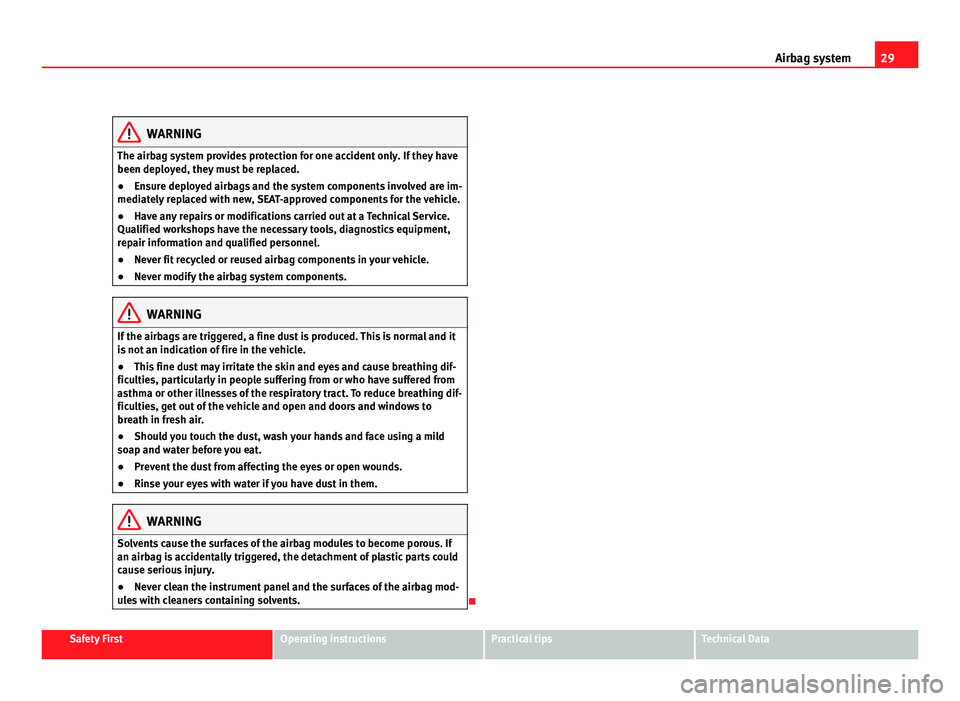
29
Airbag system WARNING
The airbag system provides protection for one accident only. If they have
been deplo y
ed, they must be replaced.
● Ensure deployed airbags and the system components involved are im-
mediately
replaced with new, SEAT-approved components for the vehicle.
● Have any repairs or modifications carried out at a Technical Service.
Qualified work
shops have the necessary tools, diagnostics equipment,
repair information and qualified personnel.
● Never fit recycled or reused airbag components in your vehicle.
● Never modify the airbag system components. WARNING
If the airbags are triggered, a fine dust is produced. This is normal and it
is not
an indication of fire in the vehicle.
● This fine dust may irritate the skin and eyes and cause breathing dif-
ficultie
s, particularly in people suffering from or who have suffered from
asthma or other illnesses of the respiratory tract. To reduce breathing dif-
ficulties, get out of the vehicle and open and doors and windows to
breath in fresh air.
● Should you touch the dust, wash your hands and face using a mild
soap and wat
er before you eat.
● Prevent the dust from affecting the eyes or open wounds.
● Rinse your eyes with water if you have dust in them. WARNING
Solvents cause the surfaces of the airbag modules to become porous. If
an airbag i s
accidentally triggered, the detachment of plastic parts could
cause serious injury.
● Never clean the instrument panel and the surfaces of the airbag mod-
ule
s with cleaners containing solvents.
Safety First Operating instructions Practical tips Technical Data
Page 32 of 385
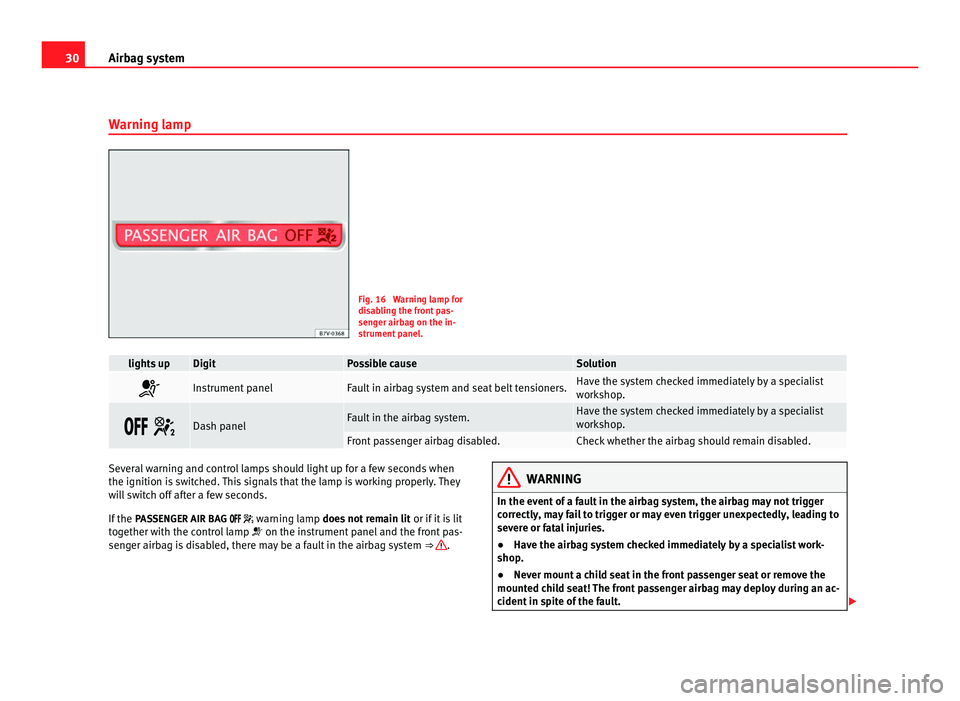
30
Airbag system
Warning lamp Fig. 16 Warning lamp for
dis
ab
ling the front pas-
senger airbag on the in-
strument panel. lights up Digit Possible cause Solution
Instrument panel Fault in airbag system and seat belt tensioners. Have the system checked immediately by a specialist
work
shop
. Dash panel Fault in the airbag system. Have the system checked immediately by a specialist
work
shop
. Front passenger airbag disabled. Check whether the airbag should remain disabled.
Several warning and control lamps should light up for a few seconds when
the ignition is
sw
itched. This signals that the lamp is working properly. They
will switch off after a few seconds.
If the PASSENGER AIR BAG warning lamp does not remain lit or if it is lit
together with the control lamp on the instrument panel and the front pas-
senger airbag is disabled, there may be a fault in the airbag system ⇒ . WARNING
In the event of a fault in the airbag system, the airbag may not trigger
corr ectly
, may fail to trigger or may even trigger unexpectedly, leading to
severe or fatal injuries.
● Have the airbag system checked immediately by a specialist work-
shop.
● Never mou
nt a child seat in the front passenger seat or remove the
mounted c
hild seat! The front passenger airbag may deploy during an ac-
cident in spite of the fault.
Page 33 of 385
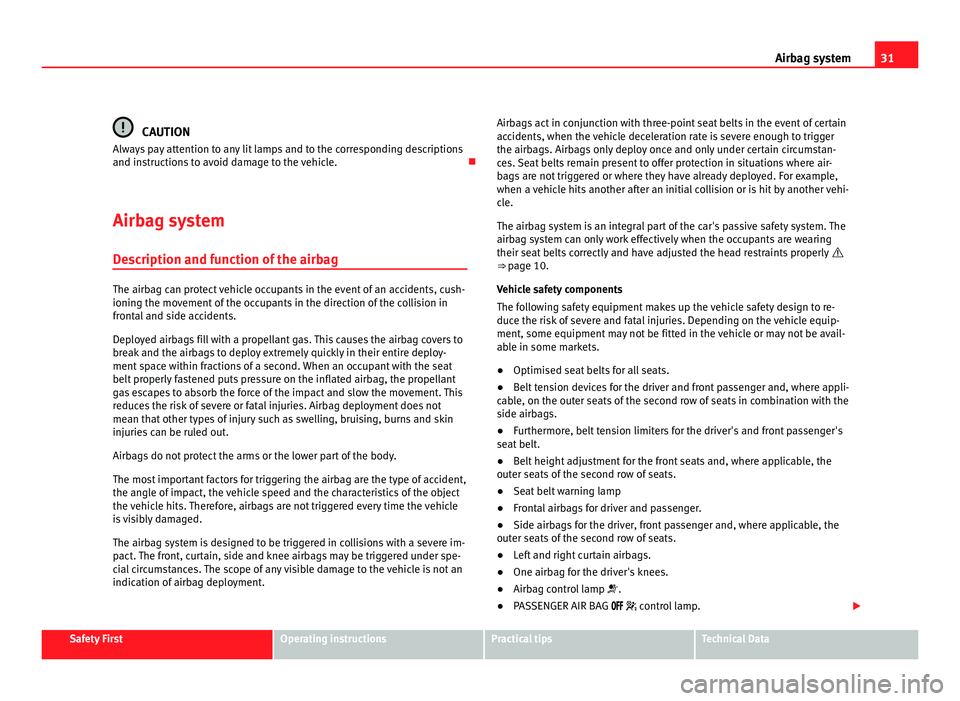
31
Airbag system CAUTION
Always pay attention to any lit lamps and to the corresponding descriptions
and ins truction
s to avoid damage to the vehicle.
Airbag system Des
cription and function of the airbag The airbag can protect vehicle occupants in the event of an accidents, cush-
ioning the mo
v
ement of the occupants in the direction of the collision in
frontal and side accidents.
Deployed airbags fill with a propellant gas. This causes the airbag covers to
break and the airbags to deploy extremely quickly in their entire deploy-
ment space within fractions of a second. When an occupant with the seat
belt properly fastened puts pressure on the inflated airbag, the propellant
gas escapes to absorb the force of the impact and slow the movement. This
reduces the risk of severe or fatal injuries. Airbag deployment does not
mean that other types of injury such as swelling, bruising, burns and skin
injuries can be ruled out.
Airbags do not protect the arms or the lower part of the body.
The most important factors for triggering the airbag are the type of accident,
the angle of impact, the vehicle speed and the characteristics of the object
the vehicle hits. Therefore, airbags are not triggered every time the vehicle
is visibly damaged.
The airbag system is designed to be triggered in collisions with a severe im-
pact. The front, curtain, side and knee airbags may be triggered under spe-
cial circumstances. The scope of any visible damage to the vehicle is not an
indication of airbag deployment. Airbags act in conjunction with three-point seat belts in the event of certain
accidents, when the
vehicle deceleration rate is severe enough to trigger
the airbags. Airbags only deploy once and only under certain circumstan-
ces. Seat belts remain present to offer protection in situations where air-
bags are not triggered or where they have already deployed. For example,
when a vehicle hits another after an initial collision or is hit by another vehi-
cle.
The airbag system is an integral part of the car's passive safety system. The
airbag system can only work effectively when the occupants are wearing
their seat belts correctly and have adjusted the head restraints properly
⇒ page 10.
Vehicle safety components
The following safety equipment makes up the vehicle safety design to re-
duce the risk of severe and fatal injuries. Depending on the vehicle equip-
ment, some equipment may not be fitted in the vehicle or may not be avail-
able in some markets.
● Optimised seat belts for all seats.
● Belt tension devices for the driver and front passenger and, where appli-
cabl
e, on the outer seats of the second row of seats in combination with the
side airbags.
● Furthermore, belt tension limiters for the driver's and front passenger's
seat belt
.
● Belt height adjustment for the front seats and, where applicable, the
outer seats
of the second row of seats.
● Seat belt warning lamp
● Frontal airbags for driver and passenger.
● Side airbags for the driver, front passenger and, where applicable, the
outer seats
of the second row of seats.
● Left and right curtain airbags.
● One airbag for the driver's knees.
● Airbag control lamp .
● PASSENGER AIR BAG contro
l lamp. Safety First Operating instructions Practical tips Technical Data
Page 34 of 385
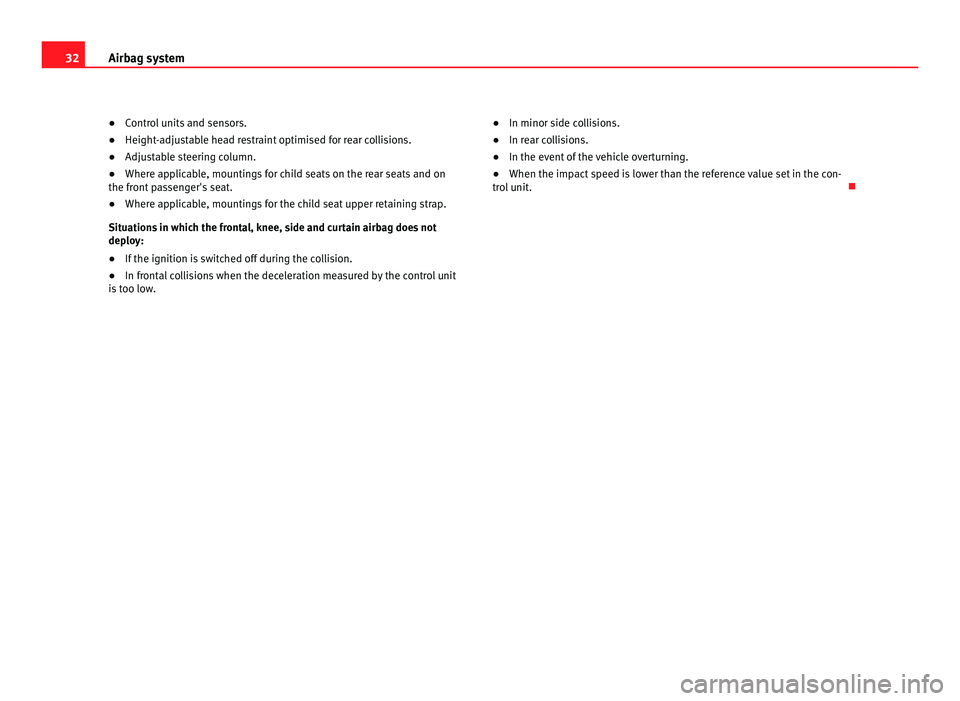
32
Airbag system
● Control units and sensors.
● Height -
adjustable head restraint optimised for rear collisions.
● Adjustable steering column.
● Where applicable, mountings for child seats on the rear seats and on
the front p
assenger's seat.
● Where applicable, mountings for the child seat upper retaining strap.
Situations
in which the frontal, knee, side and curtain airbag does not
deploy:
● If the ignition is switched off during the collision.
● In frontal collisions when the deceleration measured by the control unit
is t
oo low. ●
In minor side co
llisions.
● In rear collisions.
● In the event of the vehicle overturning.
● When the impact speed is lower than the reference value set in the con-
trol
unit.
Page 35 of 385
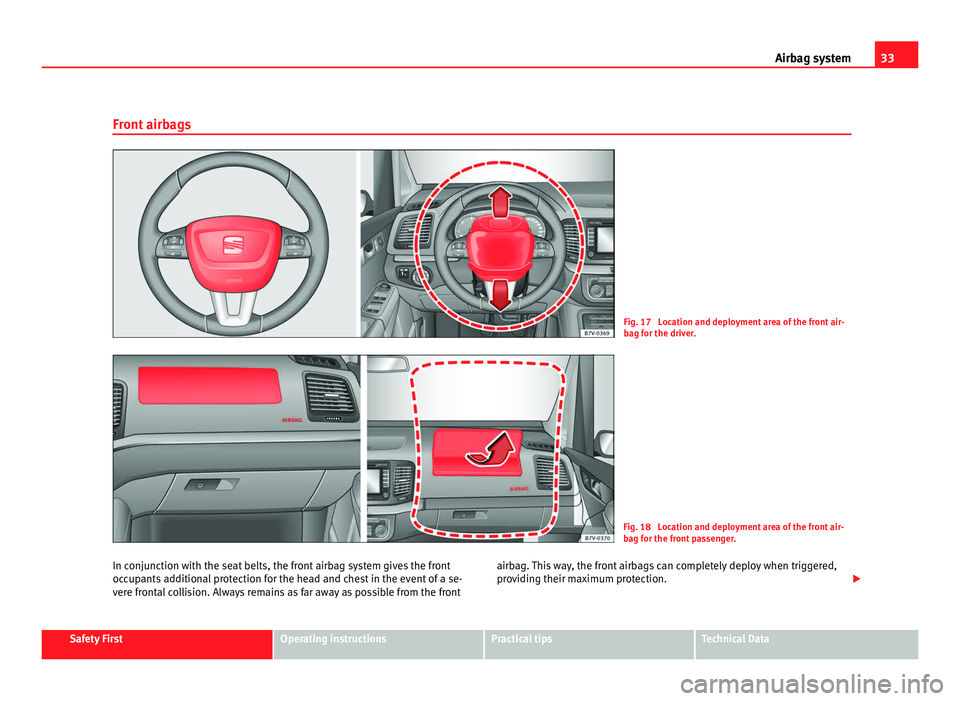
33
Airbag system
Front airbags Fig. 17 Location and deployment area of the front air-
bag f
or the driv
er. Fig. 18 Location and deployment area of the front air-
bag f
or the fr
ont passenger.
In conjunction with the seat belts, the front airbag system gives the front
occup
ants additional protection for the head and chest in the event of a se-
vere frontal collision. Always remains as far away as possible from the front airbag. This way, the front airbags can completely deploy when triggered,
prov
iding their maximum protection. Safety First Operating instructions Practical tips Technical Data
Page 36 of 385
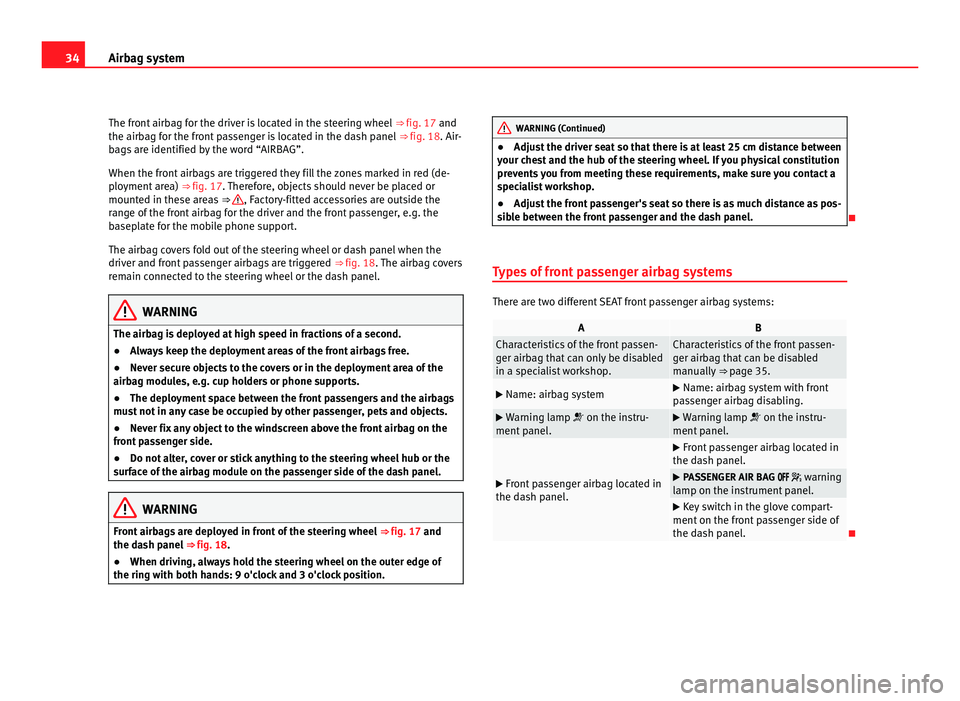
34
Airbag system
The front airbag for the driver is located in the steering wheel ⇒ fig. 17 and
the airb ag for the front passenger is located in the dash panel ⇒ fig. 18. Air-
bags are identified by the word “AIRBAG”.
When the front airbags are triggered they fill the zones marked in red (de-
ployment area) ⇒ fig. 17. Therefore, objects should never be placed or
mounted in these areas ⇒ , Factory-fitted accessories are outside the
ran g
e of the front airbag for the driver and the front passenger, e.g. the
baseplate for the mobile phone support.
The airbag covers fold out of the steering wheel or dash panel when the
driver and front passenger airbags are triggered ⇒ fig. 18. The airbag covers
remain connected to the steering wheel or the dash panel. WARNING
The airbag is deployed at high speed in fractions of a second.
● Always keep the deployment areas of the front airbags free.
● Never secure objects to the covers or in the deployment area of the
airbag modu l
es, e.g. cup holders or phone supports.
● The deployment space between the front passengers and the airbags
must
not in any case be occupied by other passenger, pets and objects.
● Never fix any object to the windscreen above the front airbag on the
front p
assenger side.
● Do not alter, cover or stick anything to the steering wheel hub or the
surf
ace of the airbag module on the passenger side of the dash panel. WARNING
Front airbags are deployed in front of the steering wheel ⇒ fig. 17 and
the da sh p
anel ⇒ fig. 18.
● When driving, always hold the steering wheel on the outer edge of
the ring with both h
ands: 9 o'clock and 3 o'clock position. WARNING (Continued)
● Adju st the driver seat so that there is at least 25 cm distance between
y our c
hest and the hub of the steering wheel. If you physical constitution
prevents you from meeting these requirements, make sure you contact a
specialist workshop.
● Adjust the front passenger's seat so there is as much distance as pos-
sibl
e between the front passenger and the dash panel.
Types of front passenger airbag systems There are two different SEAT front passenger airbag systems:
A B
Characteristics of the front passen-
ger airb
ag th
at can only be disabled
in a specialist workshop. Characteristics of the front passen-
ger airb
ag th
at can be disabled
manually ⇒ page 35.
Name: airbag sy s
tem
Name: airbag sy s tem with front
passenger airbag disabling.
Warning lamp on the in s
tru-
ment panel.
Warning lamp on the in s tru-
ment panel.
Front passenger airbag located in
the d a
sh panel.
Front passenger airbag located in
the d a
sh panel.
PASSENGER AIR BAG warning
l amp on the in
strument panel.
Key switch in the glove compart-
ment on the fr
ont passenger side of
the dash panel.
Page 37 of 385
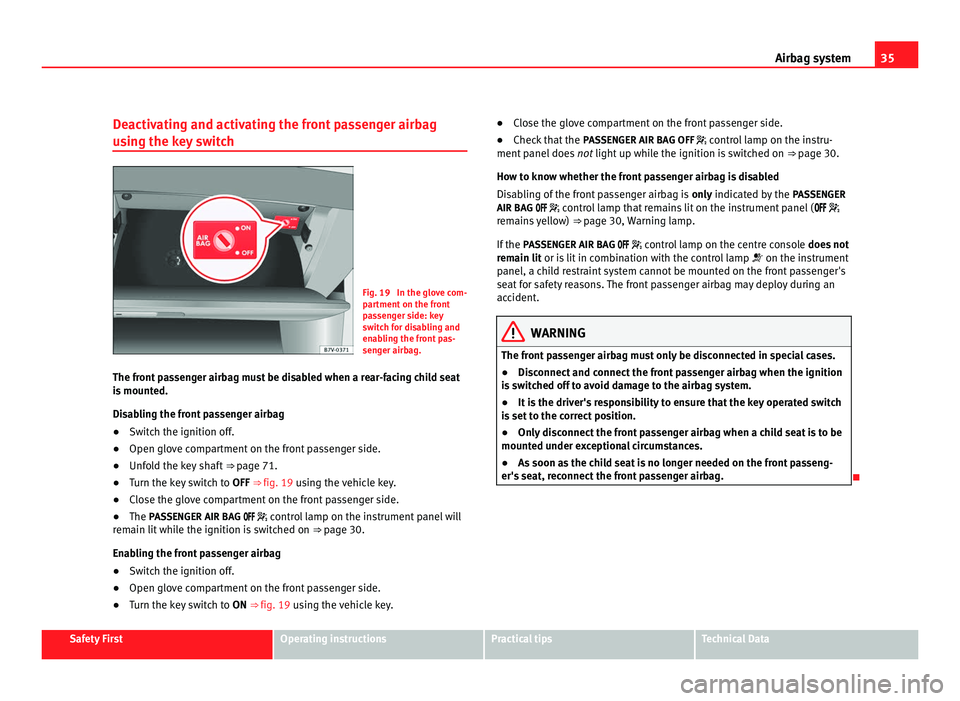
35
Airbag system
Deactivating and activating the front passenger airbag
us in
g the key switch Fig. 19 In the glove com-
par
tment
on the front
passenger side: key
switch for disabling and
enabling the front pas-
senger airbag.
The front passenger airbag must be disabled when a rear-facing child seat
is mou
nted.
Disabling the front passenger airbag
● Switch the ignition off.
● Open glove compartment on the front passenger side.
● Unfold the key shaft ⇒ page 71.
● T
urn the key switch to OFF ⇒ fig. 19 usin
g the vehicle key.
● Close the glove compartment on the front passenger side.
● The PASSENGER AIR BAG
control lamp on the instrument panel will
remain lit while the ignition is switched on ⇒ page 30.
Enabling the front passenger airbag
● Switch the ignition off.
● Open glove compartment on the front passenger side.
● Turn the key switch to ON ⇒ fig. 19 u
sing the vehicle key. ●
Close the glove compartment on the front passenger side.
● Check
that the PASS
ENGER AIR BAG OFF control lamp on the instru-
ment panel does not light up while the ignition is switched on ⇒ page 30.
How to know whether the front passenger airbag is disabled
Disabling of the front passenger airbag is only indicated by the PASSENGER
AIR BAG control lamp that remains lit on the instrument panel (
remains yellow) ⇒ page 30, Warning lamp.
If the PASSENGER AIR BAG control lamp on the centre console does not
remain lit or is lit in combination with the control lamp on the instrument
panel, a child restraint system cannot be mounted on the front passenger's
seat for safety reasons. The front passenger airbag may deploy during an
accident. WARNING
The front passenger airbag must only be disconnected in special cases.
● Disconnect and connect the front passenger airbag when the ignition
is sw
itched off to avoid damage to the airbag system.
● It is the driver's responsibility to ensure that the key operated switch
is set
to the correct position.
● Only disconnect the front passenger airbag when a child seat is to be
mounted u
nder exceptional circumstances.
● As soon as the child seat is no longer needed on the front passeng-
er's seat, r
econnect the front passenger airbag.
Safety First Operating instructions Practical tips Technical Data
Page 38 of 385
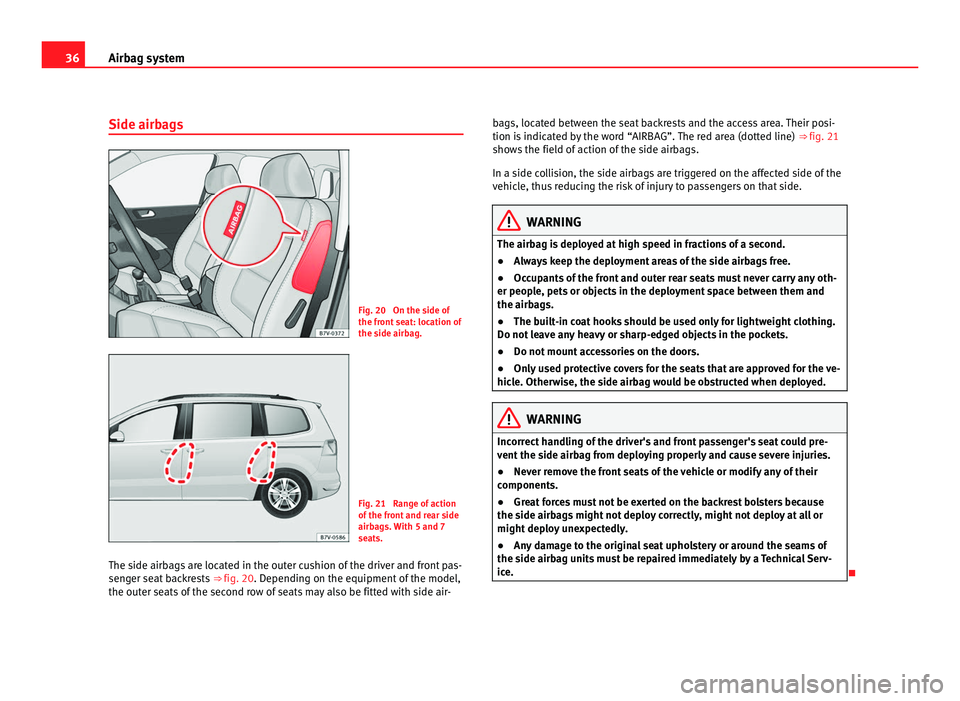
36
Airbag system
Side airbags Fig. 20 On the side of
the front
se
at: location of
the side airbag. Fig. 21 Range of action
of the fr
ont
and rear side
airbags. With 5 and 7
seats.
The side airbags are located in the outer cushion of the driver and front pas-
senger se
at backrests ⇒ fig. 20. Depending on the equipment of the model,
the outer seats of the second row of seats may also be fitted with side air- bags, located between the seat backrests and the access area. Their posi-
tion is indic
ated by the word “AIRBAG”. The red area (dotted line) ⇒ fig. 21
shows the field of action of the side airbags.
In a side collision, the side airbags are triggered on the affected side of the
vehicle, thus reducing the risk of injury to passengers on that side. WARNING
The airbag is deployed at high speed in fractions of a second.
● Always keep the deployment areas of the side airbags free.
● Occupants of the front and outer rear seats must never carry any oth-
er peopl e, pet
s or objects in the deployment space between them and
the airbags.
● The built-in coat hooks should be used only for lightweight clothing.
Do not le
ave any heavy or sharp-edged objects in the pockets.
● Do not mount accessories on the doors.
● Only used protective covers for the seats that are approved for the ve-
hicle. Other
wise, the side airbag would be obstructed when deployed. WARNING
Incorrect handling of the driver's and front passenger's seat could pre-
vent the s
ide airbag from deploying properly and cause severe injuries.
● Never remove the front seats of the vehicle or modify any of their
components.
● Gr
eat forces must not be exerted on the backrest bolsters because
the side airbag
s might not deploy correctly, might not deploy at all or
might deploy unexpectedly.
● Any damage to the original seat upholstery or around the seams of
the side airbag u
nits must be repaired immediately by a Technical Serv-
ice.
Page 39 of 385
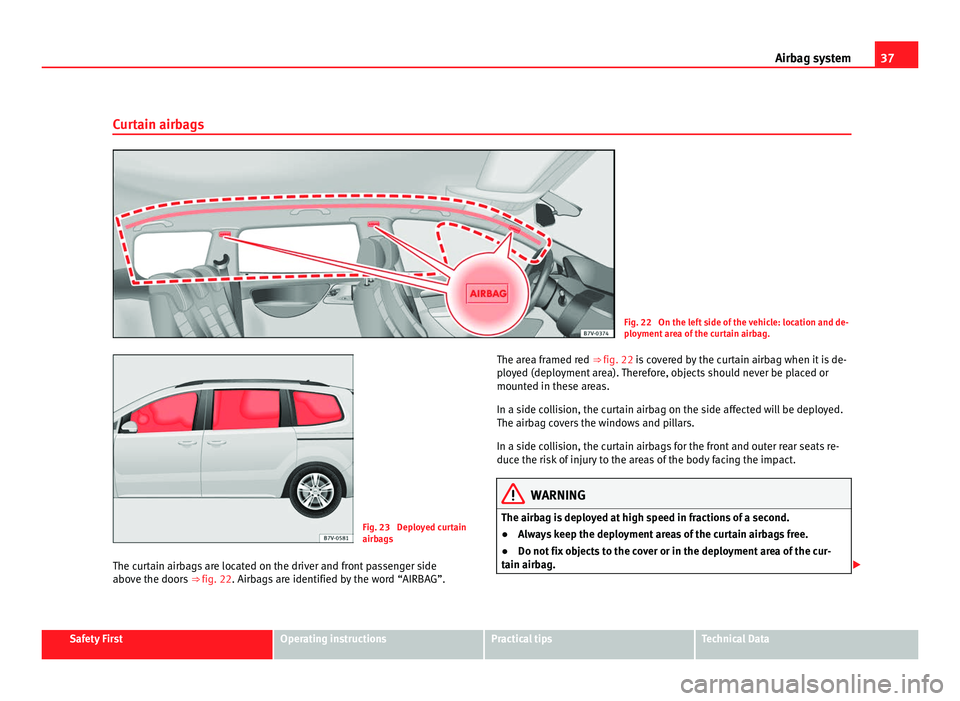
37
Airbag system
Curtain airbags Fig. 22 On the left side of the vehicle: location and de-
plo
yment
area of the curtain airbag. Fig. 23 Deployed curtain
airbag
s
The c
urtain airbags are located on the driver and front passenger side
above the door
s ⇒ fig. 22. Airbags are identified by the word “AIRBAG”. The area framed red ⇒ fig. 22 is c
overed by the curtain airbag when it is de-
ployed (deployment area). Therefore, objects should never be placed or
mounted in these areas.
In a side collision, the curtain airbag on the side affected will be deployed.
The airbag covers the windows and pillars.
In a side collision, the curtain airbags for the front and outer rear seats re-
duce the risk of injury to the areas of the body facing the impact. WARNING
The airbag is deployed at high speed in fractions of a second.
● Always keep the deployment areas of the curtain airbags free.
● Do not fix objects to the cover or in the deployment area of the cur-
tain airb ag. Safety First Operating instructions Practical tips Technical Data
Page 40 of 385
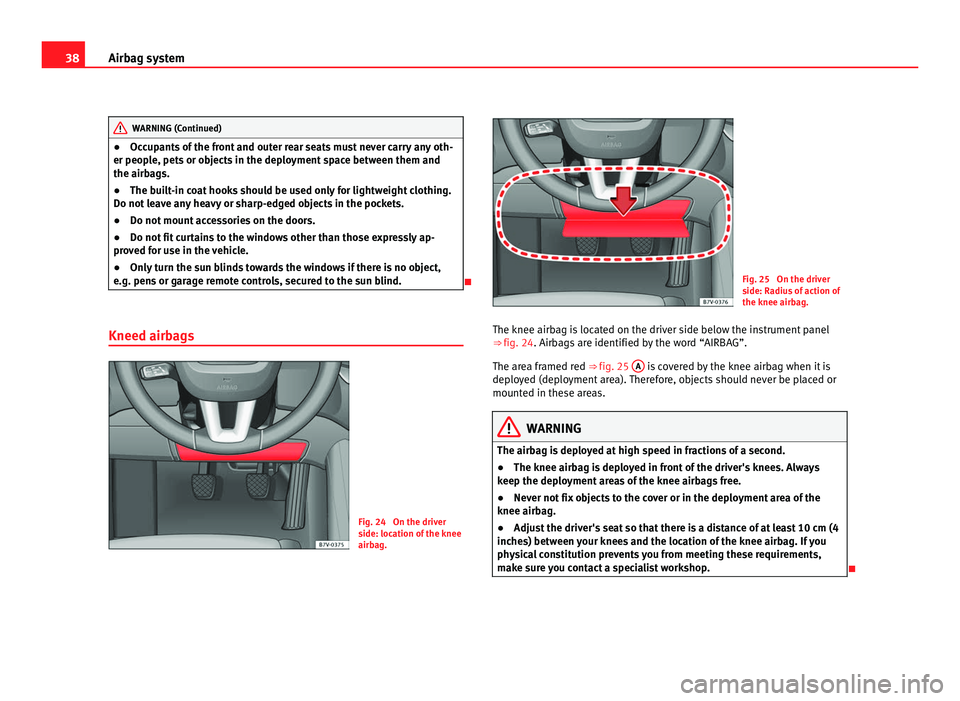
38
Airbag system WARNING (Continued)
● Occupants of the front and outer rear seats must never carry any oth-
er peop l
e, pets or objects in the deployment space between them and
the airbags.
● The built-in coat hooks should be used only for lightweight clothing.
Do not le
ave any heavy or sharp-edged objects in the pockets.
● Do not mount accessories on the doors.
● Do not fit curtains to the windows other than those expressly ap-
prov
ed for use in the vehicle.
● Only turn the sun blinds towards the windows if there is no object,
e.g. pens
or garage remote controls, secured to the sun blind.
Kneed airbags Fig. 24 On the driver
side: loc
ation of
the knee
airbag. Fig. 25 On the driver
side: R
a
dius of action of
the knee airbag.
The knee airbag is located on the driver side below the instrument panel
⇒ fig. 24. Airbags
are identified by the word “AIRBAG”.
The area framed red ⇒ fig. 25 A is covered by the knee airbag when it is
deplo y
ed (deployment area). Therefore, objects should never be placed or
mounted in these areas. WARNING
The airbag is deployed at high speed in fractions of a second.
● The knee airbag is deployed in front of the driver's knees. Always
keep the dep lo
yment areas of the knee airbags free.
● Never not fix objects to the cover or in the deployment area of the
knee airbag.
● Adjus
t the driver's seat so that there is a distance of at least 10 cm (4
inches) betw
een your knees and the location of the knee airbag. If you
physical constitution prevents you from meeting these requirements,
make sure you contact a specialist workshop.